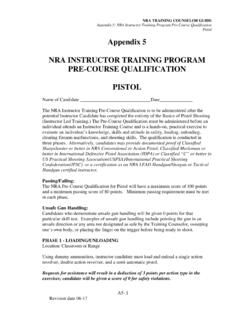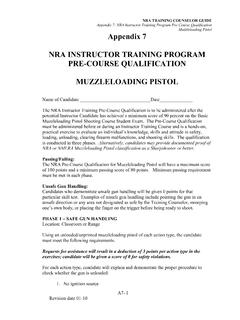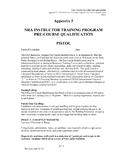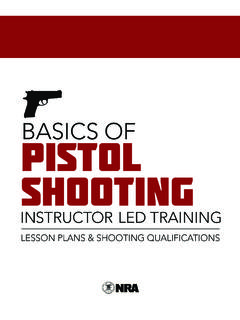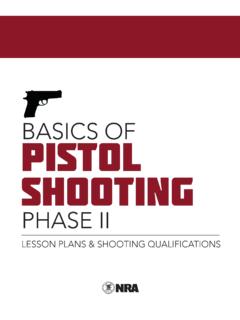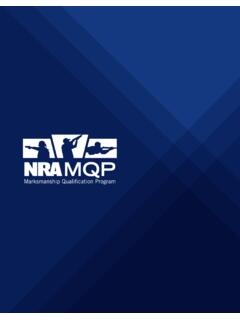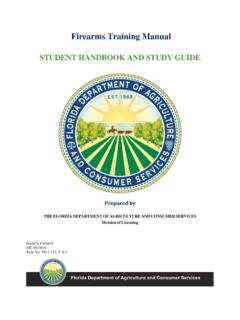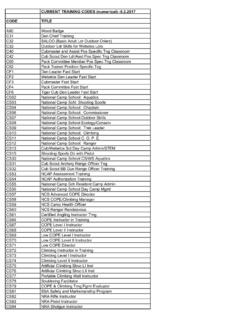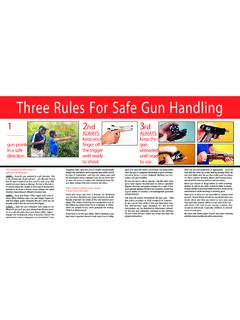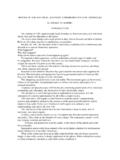Transcription of BASICS OF PISTOL shooting
1 BASICS OFINSTRUCTOR LED TRAININGLESSON PLANS & shooting QUALIFICATIONSPISTOL shootingNRA BASICS of PISTOL shooting 1 INTRODUCTION The NRA Basic PISTOL shooting course introduces students to the knowledge, skills and attitude necessary for owning and using a PISTOL safely. Through this course , the students will learn about PISTOL parts and operation, ammunition, gun safety, PISTOL shooting fundamentals, and PISTOL shooting activities. The Basic PISTOL course will also help prepare the student for participation in other NRA courses. In order to uphold the NRA s adherence to safety, and to maintain standardization among all NRA courses, adhere to the following guidelines when conducting the NRA Basic PISTOL course . course Outline and Lesson Plans The key to conducting a successful Basic PISTOL shooting course is to be well organized and know the subject.
2 The course outline and lesson plans are designed to help you in these areas so that you can spend your time teaching, not trying to figure out what to teach. This course outline identifies the: course goal Length of course Student text course lessons To maintain national standards for this program, the NRA has developed lesson plans for you. Each lesson plan provides the: Lesson title Learning objectives Estimated length of lesson Recommended training aids Lesson references Lesson content outline Instructional notes Key to training aid or text references Combined with the information found in the NRA Trainer s Guide ( Planning and Conducting Your NRA course ), the material presented in this course outline will put you on the road to success. The learning objectives are your road map--use them.
3 NRA BASICS of PISTOL shooting 2 course Length and Time Requirements The course length of the NRA Basic PISTOL shooting course is based on the estimated length of each lesson indicated in the lesson plans. The actual course length may vary from this figure, as the time required for each lesson will vary because of class size, facilities, instructor experience, student experience and comprehension level, student-to-instructor ratio, weather, and unforeseen circumstances. This course has been designed to allow for maximum flexibility in scheduling. It may be conducted a few hours at a time over several days or it may be conducted as a one-day course . Instructors teaching this course for the first time, those mentoring new instructors, or those who do not have the support of an experienced instructor team should factor in additional time.
4 It is better to plan a longer course and finish early than to run overtime or cut a lesson short. With experience gained by teaching from these lesson plans, you will soon be able to plan an entire course accurately and adhere strictly to your schedule. The course Is Based on Objectives This course is objective based. The instructor must ensure students have met the learning objectives before successfully completing the course . This may take more or less time than indicated in the lesson plans. All of the objectives are stated in terms of student performance, , what the students will be able to do at the conclusion of the lesson. Explanations and demonstrations provided by the instructors are not to be confused with meeting a learning objective. The students must be able to perform each objective.
5 To track your students performance through the course , the instructor needs to use the Performance Requirements Checklist, located in Appendix 4. Instructors are authorized to make photocopies of Appendix 4 as needed. Courses may be conducted for one specific PISTOL platform. (Semi-automatic or Revolver) In this instance the platform used must be listed on the completion certificate. Each instructor must review and acknowledge a Memorandum of Understanding regarding the roles and responsibilities of being an NRA Instructor prior to conducting the NRA BASICS of PISTOL shooting course . Instructors should provide a signed copy of the Performance Requirements Checklist to the student and keep a copy for their own records. NRA BASICS of PISTOL shooting 3 Total Participant Involvement The key to a successful and positive training experience is total participant involvement (TPI).
6 People learn by doing! Use questions, discussions, demonstrations, group interaction, and practical exercises to their maximum potential. Minimize lectures. Remember, telling is not synonymous with teaching. Student-to-Instructor Ratio During the range exercises for the NRA Basic PISTOL shooting course , a one-to-one student-to-instructor ratio on the firing line is encouraged whenever possible. If this is not possible, the ratio on the firing line should not exceed two shooters for every NRA Certified PISTOL Instructor. Whenever possible, the coach/pupil method should be used, with one student coaching the shooter on the line through the proper technique. This promotes student learning, and also provides an extra pair of eyes on the shooting line for greater safety. Additionally, it is recommended that a range safety officer oversee the safety of the entire line.
7 The range safety officer s responsibility is to ensure safety, not to give individual instruction. Depending upon the range facilities used and the number of instructors available, it may be advantageous to split the class into two or more separate groups or to use two relays for the range sessions. Emphasize Firearm Safety During every lesson, constantly emphasize in words and by your own actions that a gun must always be kept pointed in a safe direction. Be certain that students observe this rule at all times, especially when students handle guns, as in dry-fire, live-fire and gun cleaning exercises. Safety must be your foremost concern; therefore, you must personally observe all of the gun safety rules at all times, and monitor your students carefully to ensure that they are also observing these rules.
8 Whenever you pick up a PISTOL , either for demonstration purposes or to hand it to a student, always be sure to keep it pointed in a safe direction, keep your finger off the trigger, remove the magazine (if any), open the action, and visually and physically check the chamber(s) to be sure that no live round remains in the gun. Use each such occasion as an opportunity to reinforce your students gun safety training by having a student verify the unloaded condition of the PISTOL . Be sure that each student also performs this sequence of steps each time he or she picks up a PISTOL . Ensure that the student observes all of the safe gun handling rules (such as ALWAYS keep the gun pointed in a safe direction ) while he or she inspects the chamber(s) to verify that the PISTOL is empty. IMPORTANT NOTE: All training aids to be used as representation of a firearm ( : Blue guns, Laser training devices, Air Soft, Air guns, toy guns, etc.)
9 , MUST be treated in the same fashion and with the same safety rules as firearms AT ALL TIMES. Infractions against this rule will be treated exactly the same as infractions using firearms in the same manner. NRA BASICS of PISTOL shooting 4 Terminology Do not use the term weapon in this course . Weapon has a negative connotation. Use PISTOL , revolver, gun, firearm, specific model, etc. Establish Emergency Procedures Establish emergency procedures to be followed in the event of an accident. All course staff should be aware of these procedures and maintain a list of emergency telephone numbers. No Live Ammunition in the Classroom No live ammunition is permitted in the classroom. In a training environment where handling and dry firing is necessary, it is imperative that no loaded firearms be present.
10 If ammunition is not in the room, it cannot possibly get into a firearm! This protects instructors from potential liability and protects the students as well. Only dummy ammunition that is visually distinct from live ammunition is allowed in the classroom. Live ammunition may only be present on the range during live-fire exercises. Demonstrations on the Range If you have difficulty scheduling range time, or must maximize the amount of shooting and minimize dry practice while on the range, then you may want to conduct all of the dry-firing drills contained in Lessons III and IV in a classroom setting before proceeding to the range. NOTE: The benchrest exercise in Lesson III may be conducted in the classroom using firearm simulators with a resetting trigger, sights and a laser indicating shot placement.


